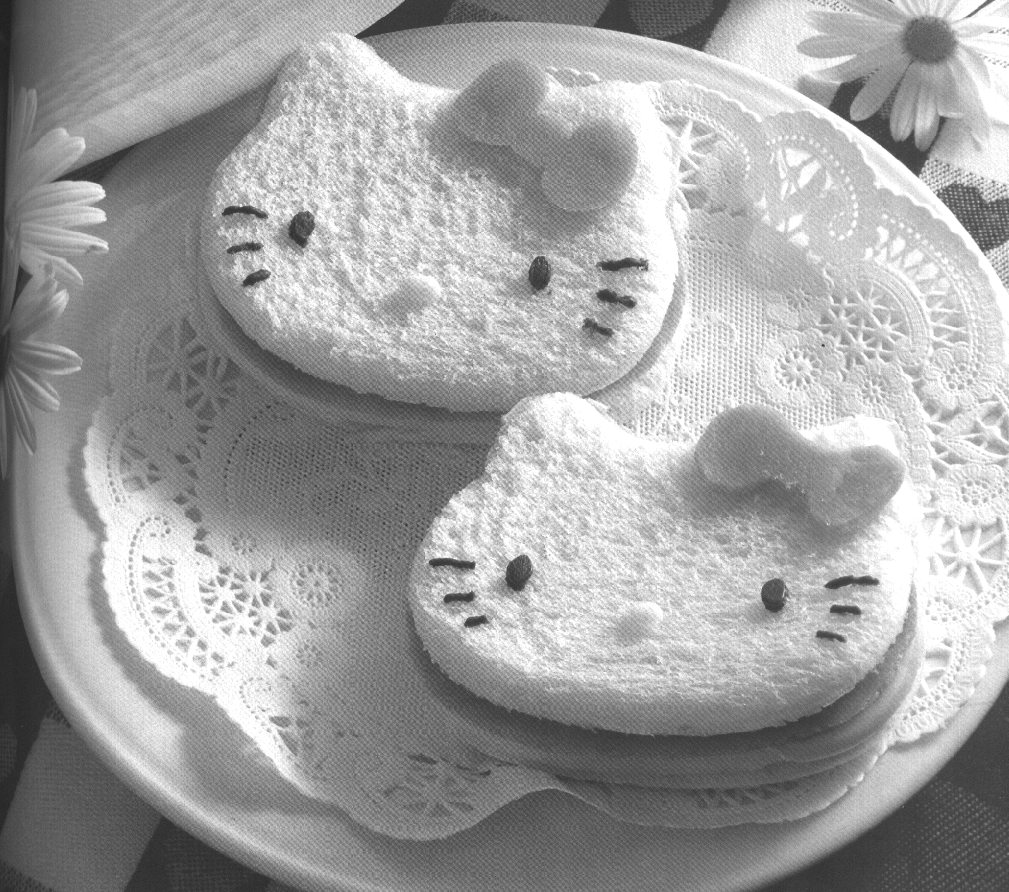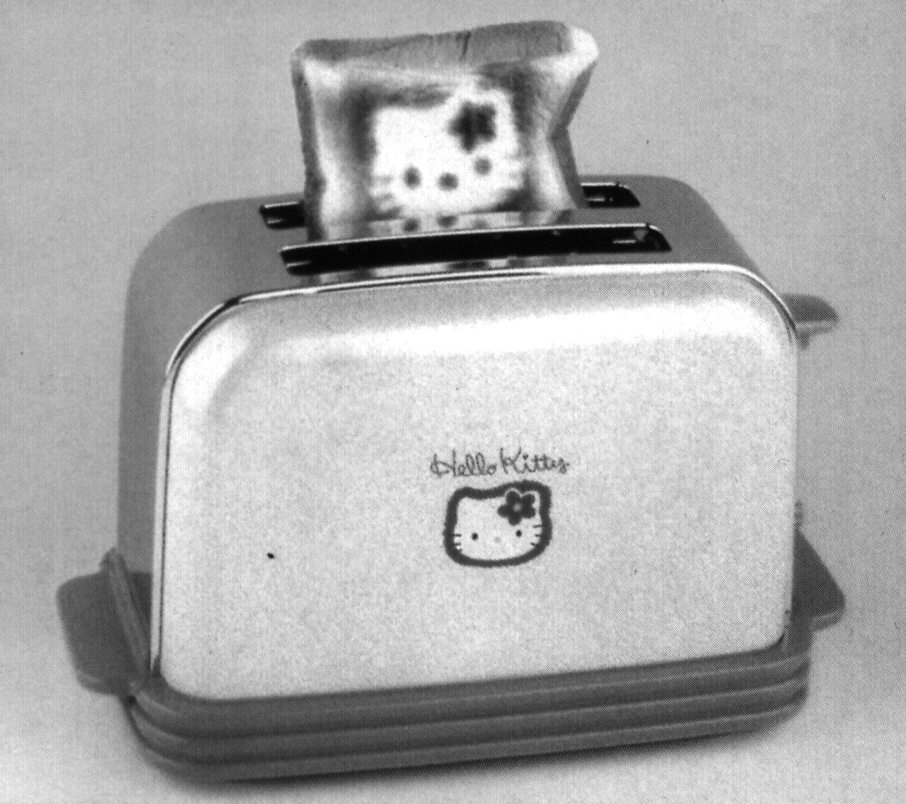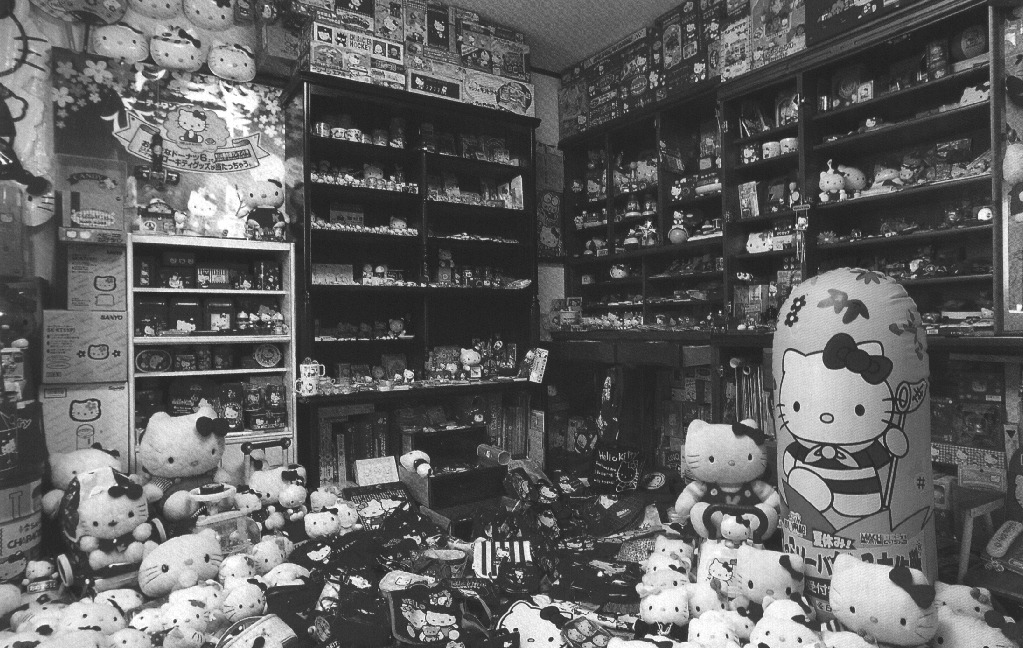Kitty Kitty Bang Bang*
The Sanrio empire is built around the creation of characters and their subsequent licencing. This represents merchandising in its purest and most distilled form: tie-ins without anything to tie to, spin-offs that revolve around nothing. You don’t buy Sanrio because of a movie or a TV show. You buy it, just because it is. And the jewel in their crown is the god-empress of cute known, for reasons lost in the mists of the 70’s, as Hello Kitty.

Kitty herself is trapped in the same kind of ageless, immortal timewarp as Barbie, locked forever in her early school years, along with twin sister Mimi and an assortment of marketable friends. But all this has been built up slowly over the years; her first appearance, on a purse, was anonymous. The name and background came later; nowadays, any true fan will reel off vital statistics such as her weight (“the same as three apples”), birthday (November 1st) and home – suburban London, albeit clearly a version of suburbia created by someone from third-hand accounts, and shaky on the basic concepts.
Kitty’s popularity is hard to explain; from a design point of view, she has an elegant simplicity of form, consisting of a few lines which even the artistically untalented like me can appreciate. Her character represents a purity and goodness of spirit whose appeal is reverberating around the world with increasing volume. Initially concentrated in the Far East, Sanrio has since spread to America, and there are even London pockets, in Hamley’s, Harrods and Selfridge’s.
Napalm Kitty – a haiku by Patrick Phipps
Napalm burns brightly
As Hello Kitty calls in
Another air strike
Sure, there’s a certain sarcasm in the way Hello Kitty has been co-opted by people like rockslut (and some say husband-killer) Courtney Love. But the beauty of Hello Kitty is that it makes no difference; she rises above it all, completely unbothered, regardless of any riot grrrrrl (and whatever happened to them?) following. You can dress your Hello Kitty soft toy in pink PVC, and pierce its most intimate regions, yet Kitty remains immune; you might as well try to appropriate the Moon for ironic purposes.
The breadth of what’s on offer is frightening, both in regular style and “special editions”, such as Angel Kitty, exclusively available in the West. Though Hello Kitty with wings and a halo does not really bear close examination – kinda implies that she is <sniff> dead…
The bible of all such things are the multiple volumes of the ‘Kitty Goods’ catalogue, an essential, largely incomprehensible (being in Japanese) guide to the Kittyverse. But what matters is not the text, it’s the pictures. It is hardly any exaggeration to say that you could outfit your entire life with Kittymabilia, from the slippers you put on in the morning, to the toothpaste you use last thing at night.
Perhaps the supreme icon of this Kitty-culture is the toaster – and not just a toaster, badged with a Sanrio logo. The machine’s Kittiness is inherent in its very essence – in what can only be termed a stroke of genius, it singes a picture of the mouthless deity herself onto the side of each slice. This is what six thousand years of civilization since the Sumerian era have been building towards.

The Top 10 of Kittymabilia
- Toaster
- Daihatsu Mira (from 794,000 yen)
- Inflatable armchair
- Mobile phone
- Bodyboard
- Rubber gloves
- Coffee grinder
- Mermaid
- Moped
- Game Boy
One of the above may be found in TC Towers, but I’m not saying which! Reports of a Hello Kitty vibrator are so far unconfirmed…
And now, those Japanese who grew up with Hello Kitty are having children of their own; hence the appearance of Hello Kitty Babies, to ensnare a future generation of Sanrioites. This seems to be working: Sanrio have stood up to the Asian economic crash robustly (sales actually went up 5% last year, to a disturbing 150 billion yen – that’s 750 million pounds, which is an awful lot of moist towelettes), possibly because Hello Kitty and her pals represent a safe haven from all that nasty unpleasantness.
For a few, however, it’s less a haven than a way of life. When the Japanese decide to do something, it’s usually with maximum dedication & effort, regardless of whether that something is pro-wrestling, war-crimes, economic expansion or, as in this case, acquiring industrial volumes of kawai – the Japanese term for cute. Some Sanrio fans therefore go for it bigtime, and the catalogue reveals rooms which contain so much HK that they would seem to be in danger of collapsing in on themselves into some sort of cheerful, pinkish singularity. Now, that’s really scary…
*Thanks to Jonathan C for (unwittingly!) supplying the title of this article…
